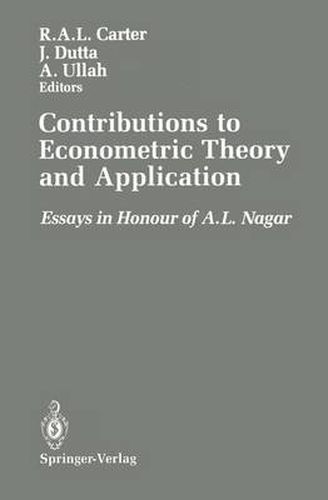Readings Newsletter
Become a Readings Member to make your shopping experience even easier.
Sign in or sign up for free!
You’re not far away from qualifying for FREE standard shipping within Australia
You’ve qualified for FREE standard shipping within Australia
The cart is loading…






This title is printed to order. This book may have been self-published. If so, we cannot guarantee the quality of the content. In the main most books will have gone through the editing process however some may not. We therefore suggest that you be aware of this before ordering this book. If in doubt check either the author or publisher’s details as we are unable to accept any returns unless they are faulty. Please contact us if you have any questions.
The purpose of this volume is to honour a pioneer in the field of econometrics, A. L. Nagar, on the occasion of his sixtieth birthday. Fourteen econometricians from six countries on four continents have contributed to this project. One of us was his teacher, some of us were his students, many of us were his colleagues, all of us are his friends. Our volume opens with a paper by L. R. Klein which discusses the meaning and role of exogenous variables in struc tural and vector-autoregressive econometric models. Several examples from recent macroeconomic history are presented and the notion of Granger-causality is discussed. This is followed by two papers dealing with an issue of considerable relevance to developing countries, such as India; the measurement of the inequality in the distribution of income. The paper by C. T. West and H. Theil deals with the problem of measuring inequality of all components of total income vvithin a region, rather than just labour income. It applies its results to the regions of the United States. The second paper in this group, by N. Kakwani, derives the large-sample distributions of several popular inequality measures, thus providing a method for drawing large-sample inferences about the differences in inequality between regions. The techniques are applied to the regions of Cote d'Ivoire. The next group of papers is devoted to econometric theory in the context of the dynamic, simultaneous, linear equations model. The first, by P. J.
$9.00 standard shipping within Australia
FREE standard shipping within Australia for orders over $100.00
Express & International shipping calculated at checkout
Stock availability can be subject to change without notice. We recommend calling the shop or contacting our online team to check availability of low stock items. Please see our Shopping Online page for more details.
This title is printed to order. This book may have been self-published. If so, we cannot guarantee the quality of the content. In the main most books will have gone through the editing process however some may not. We therefore suggest that you be aware of this before ordering this book. If in doubt check either the author or publisher’s details as we are unable to accept any returns unless they are faulty. Please contact us if you have any questions.
The purpose of this volume is to honour a pioneer in the field of econometrics, A. L. Nagar, on the occasion of his sixtieth birthday. Fourteen econometricians from six countries on four continents have contributed to this project. One of us was his teacher, some of us were his students, many of us were his colleagues, all of us are his friends. Our volume opens with a paper by L. R. Klein which discusses the meaning and role of exogenous variables in struc tural and vector-autoregressive econometric models. Several examples from recent macroeconomic history are presented and the notion of Granger-causality is discussed. This is followed by two papers dealing with an issue of considerable relevance to developing countries, such as India; the measurement of the inequality in the distribution of income. The paper by C. T. West and H. Theil deals with the problem of measuring inequality of all components of total income vvithin a region, rather than just labour income. It applies its results to the regions of the United States. The second paper in this group, by N. Kakwani, derives the large-sample distributions of several popular inequality measures, thus providing a method for drawing large-sample inferences about the differences in inequality between regions. The techniques are applied to the regions of Cote d'Ivoire. The next group of papers is devoted to econometric theory in the context of the dynamic, simultaneous, linear equations model. The first, by P. J.